Aerophone of the God L of Palenque?
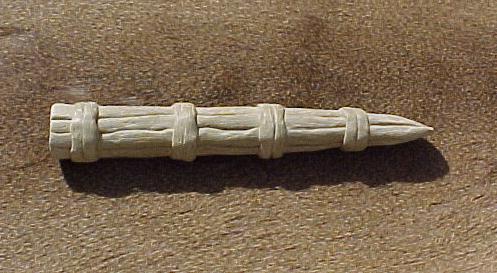
Photo of an experimental crude clay model.
Roberto Velázquez Cabrera
Virtual Research Institute Tlapitzcalzin.
This work is the first of the author that was made with the advise and help of an researcher of INAH Jesús Mora1.
(consultative document in construction)
First version July 19, 2003. Last version September 8, 2003
(Versión en Español)
Introduction
The object of this exercise is to analyze a possible sonorous device that it is held on the palm of the hands of the called God L. It is carved in a tablet of the Temple of the Cross of Palenque. It seems that its designation is by the first glyph that appears in the superior part of the stone representation. The carving in stone has been drawn and photographed for a long time.
Photo of the drawing of the carving of the Temple of the Cross of Palenque. The drawing of Volume I from "Mexico through the Centuries" (1953) of Alfredo Chavero, is in black and white. Colors were added with Photoshop to emphasize the objects under analysis. It seems that the original drawing is of Stephens and Catherwood (1842).
The drawing of the God L of Palenque, available for study in FAMSI site10, is the most detailed and in big format that was found in the network.
The last photos of drawings of the jamb of the Temple de la Cruz of Palenque were published in an article of Tomás Pérez Suárez on the Pochó; a Dance of Carnival in Tenosique Tabasco, the magazine of Mexican Archaeology 5.
The exercise is virtual or experimental and tries to show that it is possible to take advantage of the iconographic representations carved in stone to analyze hypothesis of the mexican organology and their possible relation with their ancient gods. Experimental models are used, since the original device can not be analyzed directly, because it does not exist in the reality and its material, structures and use are not known. The hypothetical sonorous object has not existed nor in the writings of which they have analyzed and published representations of God L.
The mystery of God L has been tried to explore by several authors and diverse means, but the hypothesis raised in this work has not been considered previously. The previous analyses have been done mainly in visual form taking advantage of the Mayan iconography of similar personages. They say that those personages are associated with virgules of smoke of the tobacco, but without centering the studies in the device of the image of God L of the Temple of the Cross and without relating it to old objects sonorous that generate noises or sounds of the wind. The fact that God L appears in other places associates to the tobacco, does not exclude that the personage can produce sounds in another image. Possibly, the hypothesis of this study has not been considered, because the older sonorous devices than produce noise very are not known and because it has not been of interest to formally explore the sonorous space of the first cultures nor its generating devices of sounds.
Some investigators have mentioned that the God L of Palenque is smoking a cigarette and he is known as "the old smoker God", but detailed evidences to support that affirmation was not found. Francis Robicsek9 analized in detail the mayan smoking gods, but he did not provid direc evidences to indicate that the God L of Palenque is smoking a cigar. Last that mentioned the such possibility was Tomás Perez Suárez, in its article on the Pocho. It is possible that originally somebody has raised that hypothesis, extrapolating the idea from images of other places and it simply was adopted and repeated. That has happened in other sonorous subjects as the use of the old whistles, when they say that the ancient whistles were toys, because they say they were used in that way in ancient Europa, although now we know that they had many uses.
The idea of the maya smoker god is widely accepted. Several experts provided similar opinions 2, 6. The force of the custom to analyze the ancient iconography in silence, including the relative one to the sonorous world (sonorous devices, virgules of sound, musicians, etc.), has prevented to explore it from the acoustic point of view and that has influenced in which hypotheses of other applications are accepted with more facility, although it is not arranged of very solid evidences, without verification in the reality or by means of experimentation.
The clearest sample of the lack of interest and even opposition to explore the old sonorous space is that thousands of pre-Columbian sonorous devices exist (including hundreds of Mayan aerophones of clay) that were saved of the destruction in the conquest and the colonization, because they were buried in the subsoil or infraworld, in tombs, offerings, etc. Thousands of them were recovered, but unfortunately they are not well known by the public. Of many of them nor the images of his external forms have been presented to the public. Some Mayan whistles have been only analyzed like figurines, when their external iconography and forms are easily recognizable by their realism or appreciated by their beauty or meaning.
Many ancient sonorous artifacts were matter of sacks or pillage, but many other were found in autorized explorations and, with very few exceptions, even their archaeological reports are not known by the public.
The only known study on an important group of mayan instruments is on 356 whistles mainly of Jaina Island, of Felipe Flores and Lorenza Flores. It includes some organologic data about the whistles that give a good idea of their dimensions and structural forms, but the presented analysis is not useful to study the old sonorous devices, because the analysis have several methodological limitations and basic errors, which were commented in detail in a previous study, Virtual Analysis of Mayan Whistles, openly available.
Some extraordinary very old mexican generators of noise, not even had been recognized like such by which they found, studied and protect them, as is the case of extraordinary olmecan aerophone of ilmenita, of which they found a great amount in San Lorenzo. It seems that they are the greater amount of similar ancient existing objects made in hard stone ~ 4.5 ton or ~ 140.000 devices, but it was not found interest in the formal anaysis of their acoustical and organological properties.
The belief that the first mesoamerican societies only had elementary technologies has prevented to explore its complex sonorous applications, like the shown ones in the extraordinary and very old panmesoamerican bucal Ehekachiktli, subfamily of noisy aerophones like those from San San Lorenzo and from Palenque?
It is comfortable and simple to accept and to adopt judgments or affirmations without analyzing thorough his foundations, but that prevents to explore other possibilities, like those of this work, that includes the points of view of the related technical fields and the associated physical phenomena: organologic, sonorous, dynamic of fluids, aerodynamics and signals, as well as of the iconography and another archaeological and biological information that can be available.
The main hypothesis of the study is that the tube (ocher color in the drawing) that appears in the representation is not a cigarette and can be an old generator of noise of God L, but some evidences indicate that also it could be of the God of the Mayan wind Gucumatz or Votan.
The assumption of the analysis is that the image recorded in the tablet is realistic, same that is considered reasonable by the excellent stone work made of that type by the ancient masters-artists of Palenque.
General analysis and evidences.
The technical evidences and of common sense, supported with some simple experiments and photos of smoke and fire, that are related directly to the personage and the object at issue are the following ones:
- If the object was an ignited cigarette the ends of the fingers would be burned, because they would be under the ignited part.
- The normal way to hold a cigarette is with the fingers: with the thumb and index finger or between the index and the middle fingers and not as the tube is held on the palm of the hands.
- The hot smoke of a ignited cigarette always rises and it does not lower as it is in inferior virgule of the stone representation. It is enough to ignite a cigarette to be able to confirm the previous thing. The smoke of an ignited cigarette only expands a little in all directions when it is expelled by the mouth, not when it is aspired. All smoker knows that.
- Vírgules of sounds that leave a tube can go upwards, down and to all sides, like the waves when coming out of any generator of sounds, because outside of the tube exists smaller pressure in the air. Peculiarly, the form of virgules of the pre-Hispanic iconography is similar to that shows the more advanced present analyses of simulation of the generation of sound with networks of computers and the dynamics of turbulent fluids in real time using photos and smoke, applied to the generation of sounds in tubular aerophones like those of flutes and organs. That extraordinary coincidence requires a special study.
- In this case the waves of the sound have a different behavior, because its exit is not free, since the left frame that seems a wall, prevents its free movement and causes that they bounce impelling his displacement upwards, down and to all sides. In the tablet of God L there are virgules of the sounds superior and inferior, because in his representations they were used to paint only those that are in the longitudinal plane of the vertical section of the sonorous devices, perpendicular to the line of view of the observer. In other words, they did not paint the sound waves in three dimensions, only his mapping or projection to the plane of the iconographic representation, to show them with greater clarity.
- Virgules adorned with lines (yellow color in the drawing) is looked like the used ones to represent the wind or the sound, but virgules of the conventional musical instruments is a little different from the dynamics of the smoke, fire or noise.
- Nevertheless, many virgules are known that raise and lower, used to represent all type of sounds, similar to the one of God L of Palenque, like one of the mural of the Palace of the Tigers of Chichen (of "Mexico through the Centuries"), that shows the words. That raises another possible function of the tube, like a trumpet or horn to speak or to sing through it, but it is very small to make that function and the virgules of God L of Palenque does not have adornments of words or flowery songs.
- The Dresden Codex was consulted, to observe the iconographic representations of the mayan smoke. All the represented incensories with copal or incense (because in the center of the smoke the glyph pom is included) indicate that virgules of the smoke rises and never lower, and they are flat without adornments. That can be observed in some images with incensories 1 , 2, 3, 4, 5 and 6.
- It is interesting to observe that in all the cases in the Dresden Codex the fire of the incensory is a little moved away the mayan personage, possibly to avoid the effects of radiation of the heat.
- The bird (red color in the drawing) on the head of God L has a peak with tooth, similar to the peak of the mask of the mexica God of the wind and the otherworld Hehécatl. It indicates that the personage could be the God of the Mayan wind Gucumatz or Votan, as Alfredo Chavero commented. It was found experimentally that the red peak with tooth of Ehécatl can work well like an aerophone generating of wind sounds of the infraworld.
- The relation of the bird with tooth and the God of the wind already have been recognized also by Francisco Florescano.
- The tooth of the bird can be seen in the negative rubbing of the tablet obtained by Merle Greene, excellent to show very well the details and proportions of the figure and objects of the representation. It is interesting to make notice that in the data base of that rubbing it is not said that the object held on the hand is a cigarette, it says that pipe is a tube or object in the mouth. On the sex of God L it says: man or woman.
- The virgules of the image of God L are resembled which appears in the rubbing of a cranium of the Game of Ball of Chichen Itza, which they associate to the decapitation rite, reason why the sounds could be related to those of the death, like those of the aerophones of the death, pertaining to the Mexican family of roarers or aerophones generators of noise.
- In the eye of the personage and the bird they appear others similar virgules, which represent the wind and the sound, which indicates a possible relation among them.
- Also it is observed that in the external surface of the object held on the hands it has stems or heavy twigs as if they were moored, that are very different from the thin tobacco leaves.
- Some say the objects that seem feathers on the head of god L are leaves of tobbaco, but the tobbaco leaves are biger and it has different shape.
- The tube that produces virgules could be a generator of sounds of the wind. Its structure and forms can be reproduced like tubular earphones of the God of the wind of other mesoamerican cultures that produce similar horrifying sounds, like the Tlemaitl. mexica roarer of the God Ehécatl-Quetzalcoatl .
- The skin of jaguar in the back of the personage shows that also it is related to that feline, which they indicate that virgules could be associate to its roars.
- Another excellent sign is the mayan serpent with two heads that appear to both sides of the legs of the personage, who could be related to Gucumatz or Kukulkan or the Mayan Qutzalcóatl, seemed to frightful maquizcóatl, described by Bernardino de Sahagun in its "General History of the Things of the New Spain". There were other snakes related to the figures of the worked stone, as they called tleua .
- Those that even simulates the jaguar in the Pochó dance use a whistle, which can indicate that the old device could be an aerophone, but the musical sounds of a tubular whistle with embouchure of tip or peak are not related to the personage neither with the sounds of the jaguar, nor of the wind or the serpent. The dancers who imitate animals no longer use devices that simulate their sounds, by the effects of the colonization and because no longer they know how to make and to play them.
- The representation of God L has been analyzed by diverse experts in the mayan culture and other organológicas possibilities have been mentioned. One of them was of Guillaume Dupaix: that the object could be a trumpet. Tomás Perez Suárez, in his article of the Pochó, mentions that that possibility was a confusion, but the cause is not mentioned. The tube that has in the mouth God L does not seem to be a trumpet because the mayan horn are of greater dimension, as it is in the virtual analysis of trumpets of Bonampak and because the embouchures of all trumpets are not introduced in the mouth when they are played. They must operate outside and around the mouth of the player to allow the vibration of the lips that act like reeds to generate the sounds.
- The bird on the head could be a singer, but to simulate micropitch sounds of the natural birds small resonators and big pitch holes are required, as it is shown in a previous study on "singer birds of clay".
- Several representations of similar Mayan personages, who have birds on the head, but do not have tooth like the one of the God of the wind.
- There are many representations of God L who handle objects with fire or smoke. Many of them can be seen in the Data Base of Justin Kerr2, but the objects of God L in 46 vases are not equal to the tube of Palenque. The mayan personages who handle objects that seems cigarettes or tobacco in 16 vases are not like the God L of Palenque.
- There are personages that handle objects with fire like in the vase K0702, K5998 and K1228. They seem torches, but their structure and forms to handle them are different. There are virgules of torches in the iconography that show they can lower, if turns around downwards momentarily like in dances, according to the same photo of the K0702 vase and the drawings of the Codex Dresden torch 1 and 2, but if a torch is held for a moment horizontally or in any other position its virgules of the Mayan iconography shows that the flames and the smoke rise.
- In the back of the image of K0702 vase the personage has a serpent in the back that generates two big scrolls, similar to those of the image of Palenque.
- In another mayan vase (K1398), a rabbit has the clothes of the God L that is naked, including which seems a mask or hat with a bird similar to the one of the image of Palenque, but it does not see if it has tooth because its peak is closed.
- In a mayan plate (K3702) appears a personage with a great serpent on his head, which it has a bird that generates scrolls like of the image of God L of the Temple of the Cross, reason why they can be related to the sounds of a whistling snake.
- If the object at issue is not hollow, it could be an ignited torch done of moored twigs, but in that case the fire also would burn the hands of the personage and a reason is not seen to have it in the mouth, unless he is hollow and it operates like bucal aerophone of fire and that this one does not affect the hands of the God that hold it.
- Some academic ones say that God L was the God of the Mayan infraworld Xibalba. If that is certain it would have to be able to roar like the aerophone of the mask of the mixtec devil or Tachi to sound like the wind of hell.
Simple experiments with smoke, fire, talc and air.
In the network there are photos that show the dynamics of the smoke of cigarettes like the one of a smoker in which it is seen as the smoke rises, but is very simple to verify experimentally that the fire and the smoke rise, in normal conditions, without turbulence, airflow or wind.
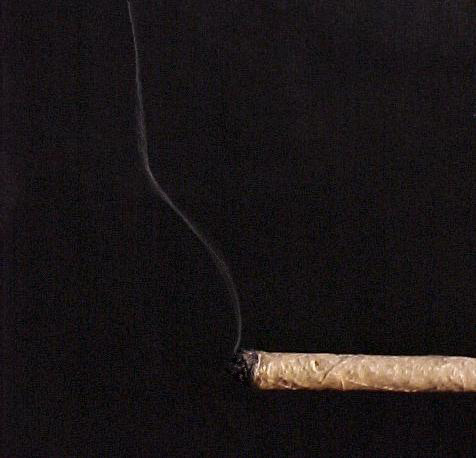
Photo of a cigar.
The smoke of a cigar rises and it is very tenuous, almost imperceptible in the photo, when the ignited dry tobacco is not excited with the oxygen of the air by the smoker.
The same it happens to the smoke of the tobacco in other shapes like in a cigarette:
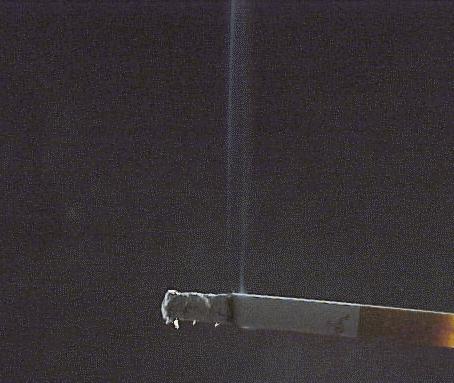
Photo of an ignited cigarette.
The smoke also rises, in this case more vertically, due to the paper.
If the device is a torch, it is possible to be simulated with an ignited wood.
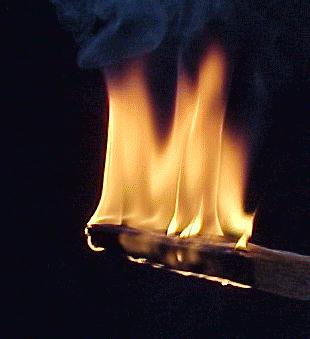
Photo of an ignited ocote.
The flame of torch is strong and it rises vertically more, by the resin of the wood that feeds the fire. If the wind is turbulent the dynamics of the smoke and sound waves can to be very different, complex and even chaotic, as it happens to the generation of sounds of the aerophones that produce the noises of the air.
Experts with equipped laboratories of fluid dynamics or aerodynamics, interested in analyzing ancient mexican aerophones or experimental models of them, have not been found, but in this case it was possible to made simple experiments to show the dynamics of the air coming out of a tube placed in front of a table to simulate the phenomenon of the device of God L of Palenque, supposing that it is an aerophone:
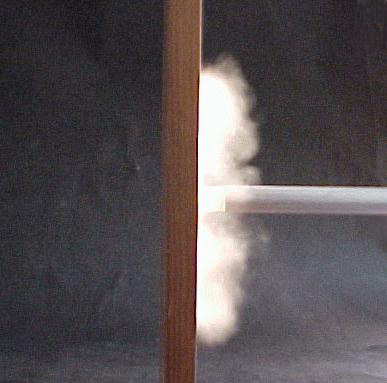
Photo of the airflow.
The airflow mixed with talc was illuminated with a light, like the used ones to illuminate jewelry display cabinets, by the right back part to visualize the dynamics of the air to the exit of the aerophone, a fraction of second later to hit the table. In order to generate the input of airflow a pump of bellows of foot was used, like those used to inflate plastic boats. The photo was taken with a cheap digital camera that does not have fast times of operation, reason why the image of virgules cannot be "congealed", but it shows the general behavior of the phenomenon. Displacement of the talc towards the front, next to the camera, also it affects the image to shown the movement of the air. A better procedure would be to repeat the experiment several times with a time delay increased in milliseconds to act the firing of a fast camera, with object to show with greater clarity a film with the dynamics of virgules, like it have done in the analysis of tubular whistles.
Nevertheless, in the obtained image can be seen that the air moves upwards, down and all sides, when hitting the table, as it shown in the representation of the God L.

Photo of the air jet without the table.
The image of the movement of the air in the photo indicates that the left frame of the tablet of God L could be a wall, since if virgules did not exist this one in the stone representation they would be similar to those of the free air jet, would not bounce towards all sides.
Experiments with sonorous models.
Next one will be, by means of experimentation, that the aerophone of the hypothesis does not belong only to the imaginary space, it can exist and roar even in ours reality.
In the representation of Palenque, it cannot be observed the internal structure nor the superior view of the conical tubular object, but as it is held with the two hands indicate that it is heavy. As the hands cover the tube partially, its width cannot be determined with exactitude. It could be constructed of several natural materials like wood, bone or stems of dry vegetables, coiled and moored twigs, palm, rinds, etc. The color of the device is not known, but the greater uncertainty is the diameter of the object, because it cannot be seen, although it unknown that its thin end is within the mouth of God L.
It is possible to consider the dimensions of the device taking advantage of the used procedure to determine those of trumpets of Bonampak murals, although in this case its exactitude is not very important, since it would only affect very little the height and the timbre of the sounds produced by the noise generator, that constitutes the heart of the sonorous system. Following that procedure, supposing that the tall average of masculine personages of the Mayan royalty is of 165 cm and considering the dimensions of photo of the complete rubbing of the God L1 (positive), the length of the ancient real device would be around 23-24 cm.
In this first model the clay was selected by the versatility in its construction and because is a little heavy. The design of the embouchure is the one of bucal Ehekachiktli of two holes and it operates in the same way. It is the simplest and the oldest of the family of noisy aerophones, but the less well-known and the one than can be more powerful. It could be used by other mesoamerican Gods of wind and it is shown in other ancient mayan images7.
It has been shown that the design can be used as a generator of noise within the peak of the mexica God Ehécatl to be adapted to a mask of the God of wind.
Also it has been proven experimentally that the extraordinary generator of noise works very well with globular or tubular resonators to produce horrifying whines of the infraworld or sounds as those of the wind of hell.
In this case, the coupled resonator is a simple truncated conical tube without pitch holes. Clay can be constructed around the internal mold of wood
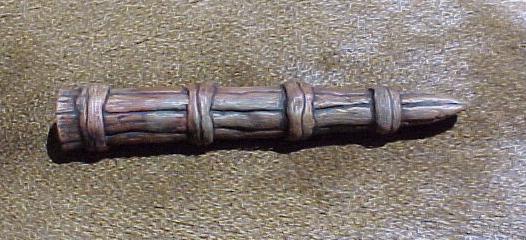
Burned experimental model after firing, of ~ 24 cm in length.
(on a deer skin)
The outer finished one of the experimental model already is very approximated to the real image of its stone representation. It was molded with modeled clay strips or little snakes of crude fine clay of Oaxaca to form the body of the tube. It was slid with black crude clay (very rare, of Nican, Juxtlahuaca, Oaxaca), to give the impression of being old and that it was extracted from the subsoil or infraworld.
One has seen that these old aerophones work with resonators of several forms and materials and its generator of noises can be constructed very well within animal heads of the mayan forest, like reptiles and felines. That is shown in the study of the buccal Ehekachiktli. Another experimental model with a guaje tube and a clay embouchure was constructed, to show that the resonator can be made of other materials and to show its connection to the embouchure with clarity, in where the chaos/noise one is generated and to show that it adapts very well to tubes of different sizes like the acocoti, guaje, gourd bottle or siceraria lagenaria.

Experimental model of guaje and burned clay embouchure. Length ~ 37 cm.
That aerophone was decorated with several veladuras of oil painting (yellow Naples, orange and green toad), to hide a little the white paste of the used glue (plaster with Resistol) and to show that the ancient and modern materials and techniques are compatible.
A model with a tube of thin wall like the guaje or another thin vegetal material, can easily be covered with twigs, branches or stems moored with palms or mecate, to obtain a very similar outer surface to the one of the image of the object of the rubbing.
Ideally, in the embouchure it must have a head of some reptile, like the serpent of the roarer Tlemaitl .
As these models are generators of chaos, the dynamics of the air when coming out is more turbulent.
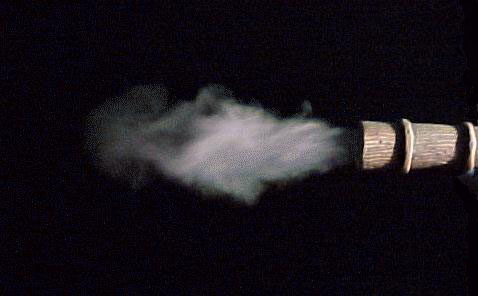
Photo of the air when coming out of a clay model, with the light to the front and the right.
The sounds that generate these experimental models are not musical and they can be disagreeable for some persons. They are similar to those of the family of analyzed noisy aerophones previously, but they are not easy to describe. The sounds seem horrifying unknown old animal roars, moaned of beings, winds of the otherworld, infraworld or hell. It is necessary to listen to them to know them in fact. The techniques of musical analysis are not useful in these cases to analyze their sounds. It is better to use tools and scientific methods to analyze complex signals, without ethnocentrists slants. For example, the main parameters (Hertz, dB and seconds) of the components of frequency of the sounds that vary in the time can show with a spectrogram.
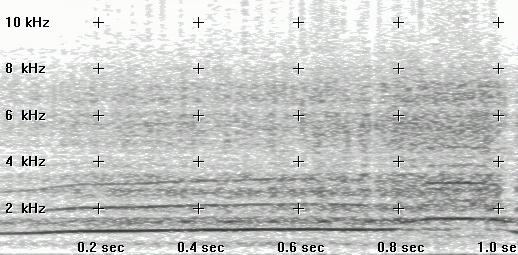
Spectrogram of the sound of the experimental clay model.
(the sound is looked like a moaned whistle or of the infraworld)
This family of aerophones has seen itself that, in spite of being very simple and even without having pitch holes, can produce different sounds, depending on the configuration of the bucal tract and the form of the input airflow. For example, using the model of guaje they can generate even bioacoustic sounds. In two the following spectrogram there are Fn of the sound, same that seems weaving serpents, as the natural ones and their mesoamerican iconographical representations and same of God L. the drawing of the signal in the space of the frequencies seems like a serpent that whistles the sound. Also it is looked like virgules of the Mexican sounds. It is that other coincidence? or they knew as their sounds in the space of the frequencies were seen as they knew his dynamics in the space the time. That is very possible, since any old whistle with a hole has been seen that that generates two tones, its spectrogram shows in the space of the frequencies that its fundamental F0 generates square signal, same that also is an old graphical symbol of the serpent, the sound or any being or weaving phenomenon.
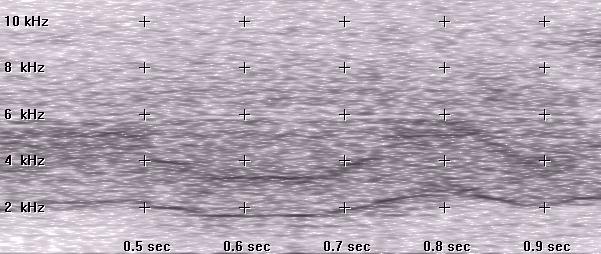
Spectrogram of a short sound of the guaje model.
The sound of the guaje model is enough strong, possibly by the greater opening of the resonator tube, which can indicate that the original tube was similar, if it was used to produce powerful sounds.
It is suitable to be used in diverse ancient mayan rites, related to the death, the devil, the fire, the infraworld or hell, the wind, the animals, etc., as well as to be congruent with the iconography of the diverse representations of the God L.
It is possible that those sounds can have special effects in the physical and mental health of the listeners, if it is played a group of similar sonorous devices at the same time in a near field, because they can produce sonic interferences and complex subsonic beats, but its verification is a matter of future investigation.
It is possible that the analyzed hypothesis can not to be certain, but that is not very probable, since it has been shown that it is congruent with the representation carved in stone and other images of the panmesoamerican God of the wind. God L could not play aerophones of wind, but there are evidences that the case could exist and to be that. One was that already it exists and it works very well acoustically. At least, already it was demonstrated that using approaches and new techniques it is possible to raise and to analyze an original hypothesis, that it had not been considered nor explored. The case shows that when the glyphs and other archaeological evidences are not sufficient to explore sonorous artifacts of the past, the experimentation can be useful to analyze new hypothesis on them.
Independent of the veracity of the raised hypothesis, the exercise shows the potentiality of use of one of the older and own sonorous designs of the mexican cultures that were created to be used in applications of communications and signals and to simulate sounds of beings of their natural surroundings and Gods, although their exact original use and its operation are unknown.
The implications of which God L of Palenque is not an old smoker are interesting. If the object that holds in the hands is a generator of noises, it would mean at least that he was an ancient master wiser than we in that matter, since now not even the possible modern uses are known of that sonorous design.
Also has been shown that it is possible to analyze and to recreate or to reinvent the rich, millenarian, destroyed, prohibited, replaced, not known, the lost one, forgotten, neglected or despised Mexican organology, even without having direct access to them, making use only of public photos of drawings and rubbings of ancient representations, like those of God L carved in stone and the one of mayan trumpets of Bonampak murals.
The analysis of the ancient iconography, from a new point of view and tools like the used in this paper, show that it can open a window to explore the past, in relation to the ancient sonorous space. The representation of each possible sonorous artifact included in the iconography may be matter of a similar paper.
Notes, commentaries of experts and permissions to use some images.
In most of the cases analyzed by the author are virtual studies, using experimental models, because they have represented the best alternative for the investigation of the ancient organology. Nevertheless, it has not only been difficult to have access to the ancient sonorous objects and their original representations, but it is not simple to use published copies of ancient representations. Even for studies with nonlucrative educative aims, like in the present, some require that permission is asked for the copy or disclose our culture and others sell the images. It is a true tragedy that becomes difficult to help to implement the constitutional orderings and of other laws to study and to divulge our indigenous and prehispanic cultures, by the mercantile objectives or the copy rigths of author protected in orderings and secondary regulations. Most of the editorials publish and sell copies of ancient representations and in many cases, without contributing to some added value or additional knowledge. The original authors of the ancient art are not know themselves. Luckily, some exemplary and excellent public data bases exist in Internet, that have given facilities to use their information in nonlucrative works, as it is the case of the mayan glasses of Justin Kerr2 the rubbings of Merle Greene 1 and the Linda Shele's drawings of FAMSI site10.
The consultative document was presented to some related experts. The received and found commentaries in the network are the following ones:
1. Jesús Mora, researcher of the Direction of Archaeological Studies (DEA) of INAH, experimentally confirmed with a cigarette the movements of the smoke, he recommended to analyze the Dresden Codex and he provided commentaries and information as the rubbings of God L and a skull of the Game of Ball of Chichen Itza, made by Merle Greene Robertson/Mesoweb ©Pre-Columbian Art Research Institute, 1995, used with permission.
Also, Jesús Mora is the first researcher of INAH interested in the analysis of ancient aerophones, because when he was Sudirector of the anterior DEA, suggested and permited the study of the Clay frogs of Yaxchilán, that were found by Daniel Juárez6. The study was made as an example in the use of a methodology included in a thesis on Mexican ancient aerophones and it was presented in the First Sessions on Acoustics of Ancient Sonorous Instruments, December, 2002, Cancun, México.
2. Justin Kerr gave permission to use photos of its data base of mayan vases. He commented that God L is associated to the tobacco in other places, reason why assumes that the image of Palenque is smoking tobacco instead of playing an instruments. Where they see that the Gods produce sounds is in almost all those that they have conch shells.
It will be interesting to analyze the evidences on the commentary of Justin Kerr of which "God L is associated to the tobacco in other places", because similar judgments from other experts are known and because interesting questions may arise. For example, what would mean that some of those evidences were not very solid or general? or that God L of other places was not only a smoker?, since it has been demonstrated with the one of Palenque. What would hapen if some tubes are not cigars, but aerophones?. For example, in the vases K3386 and K1490 there are objects that seem aerophones. In the fist vase there are objects with virgules similar to the tube of God L of Palenque. In the last vase there is an animal in the air with a small object that seems a whistle of wind and two personages with small tubes in their mouth that seem aerophones of wind, because the extreme of the tubes are covered with a hand, in the same way used to change the pitch of the aerophones of wind, forming an extra resonator or bell with the hand around the exit of the tube. The whistles of wind may be related with rites of the death. The vase shows a decapitated head. It was commented that a hand can be burned if it is near of an ignited cigarette. There are other mayan vases that show possible aerpohones of wind7.
Justin Kerr provided additional comments and information: Your paper is very interesting, however let me point out that recently, John Carlson in his study of Maya small flasks (Smoking Mirror, Washington, DC) that Gold L appears on a flask holding a tobacco leaf. The text, read by David Stuart suggests that ground tobacco (snuff) may have been contained in the flask. A picture of this flask appears in Robicsek's "The Smoking Gods". would also like to point out that the bird depicted on K7821 is Itzam Yeh and has no relation to god L. Although you show a photograph of a cigar, it is not a Maya cigar. The type of cigar smoked by the Lacadon Indians of Chiapas and is in the form of a cone. This is the cigar that is seen being smoked by the deities in the Codices."
3. Leticia Staines, of the Institute of Aesthetic Investigations of the UNAM commented: Not yet I have read all your work but it seems to me that it is an excellent proposal of interpretation of the object that takes in the mouth God L of the Temple de la Cross of Palenque, because in addition to the glyphs reading they have been the scrolls and the form of the object which gave rise to that it was said that is a cigarette, but has not been sufficient to affirm it. It is so the identification that beams is a new proposal that without a doubt is very important.
4. Joel Skidmore de Mesoweb recommended to contact to Merle Greene Robertson on the permission to use its images and to ask to her on the cigarette of God L.
5. Photos of other drawings of God L are not included now because it is necessary to request permission, since the publishers informed that any material that belongs to Mexican Archaeology and that is desired to use or to reproduce before must be authorized by the publisher.
6. Daniel Juárez Cosio, Director of the DEA, INAH, commented that there is iconography of God L associated to the tobacco or smoking cigarettes and provided some references that will be consulted, like "The Smoking Gods"of Francis Robicsek, "The Blod of Kings" of Linda Shele and Mary Ellen Miller, "The Maya book of Dead" of Donal M. Hales and books of maya iconography and dictionaries.
7. Karen Bassie comments that the wind gods on the vase K1485 have pursed lips because they are whistling and suggests to see the vase K7821. In this last vase, it seems that they are whistling, but with bucal whistles of wind, because they have the same structure and are played in the same way than the bucal Hehekachiktli. There is a big bird that is called Itzam Yeh, but with tooth like the bird of the god L of Palenque and the mask of the God of wind Ehécatl. It is possible to make an experimental model with the shape of that whistle of wind.
8. Hilary Kerrod, a fine ceramist from New Zeland, who made experiments with mexican noise generators, commented: It seems to me that there is a natural link between 'wind' and whistles (and other wind instruments) and also tobacco in that the smoke of tobacco makes breath visible. So it's not surprising that a god might be linked with both whistle music and smoking tobacco. Maybe the whistles came first -from experiments with natural hollow stones and shells-, and the use of tobacco followed? I really like the image entitled 'Foto de un modelo de barro del pico rojo de Ehécatl sobre una piel de venado.' I presume it makes a sound in the same way as the gamitadera/shepherd's whistle family? (I have been making whistles like this but with exagerated lips. The whistler looks as if they have big red lips.)
9. Francis Robicsek, in his book "The Smoking Gods", provides information on the ancient use of tobacco, by the mayas and by the Lacan Indians, as well as a lot of iconography with objects that seem cigarrettes, cigars or tobacco. The Mayan God that is more shown with objects that seem cigars is the God K. In relation to the Photos with Lacandon Indians with conic objects of tobacco (Fig. 18, p. 16 y Fig. 33, p. 31), these seem bundles and they are very large (60-70 cm) to be used as cigars. The cigars used by the Lacandon Indians are smaller and coiled by hand like the traditional and actual cigars made by hand (Fig. 19, p 17 y Fig. 20, p 18). On the God L of Palenque, it is included an detailed analysis and beliefs, but direct evidences to indicate that he is smoking a cigar are not provided. He informs that it is the only Mayan monument of stone that show the act of smoking and comments its iconography, ilustrated by the drawing of Linda Schele (Fig. 131. p. 116). On the hipotetical cigar he comments:
In his hands, in a peculiar palm-upward position, he holds a large funned-shaped cigar, which earned his popular name, "El Fumador." He is blowing smoke from the cigar, which resembles those still smoked by some of the primitive South American tribes. (Cogars of identical shape were also popular in Europe in the sixteenth century and were depicted in Juan Bautista Muñoz'Historia de Nuevo Mundo.) A small flare with two curls of smoke, just like that of God K, emerges from the forehead of the deity.
The iconographic significance of the figure, whom Spinden disrespectfully called "an aged and decrepit smoker," is uncertain. Thomson believed that his smoking is an act analogous to the North American Indians'ritual of blowing smoke to the four directions of th earth. Such customs have practiced by the Hopis, who blow smoke to the four winds during their ceremonial dances and by the Zuñis, by whom "at many points in cremonies, tobacco smoke is blown to the six cardinal points that the rain maker may not withhold their misty breath."While Arethur Miller relates El Fumador to the cigar-smoking incident in Popol Vuh, recent observations by Schele attribute astrological significance to this monument.
Also, it is included information on a ceramic container with the "God K and God L smoking", from the North of Petén. This representation is similar to the of God L of Palenque, but information or anlysis on the hipotetical cigar is not provided. The rest of the iconography was studied by Michael D. Coe in other paper.
10. Sylvia from FAMSI permited to put a link to the drawing of Linda Shele, but now it in other web page.










